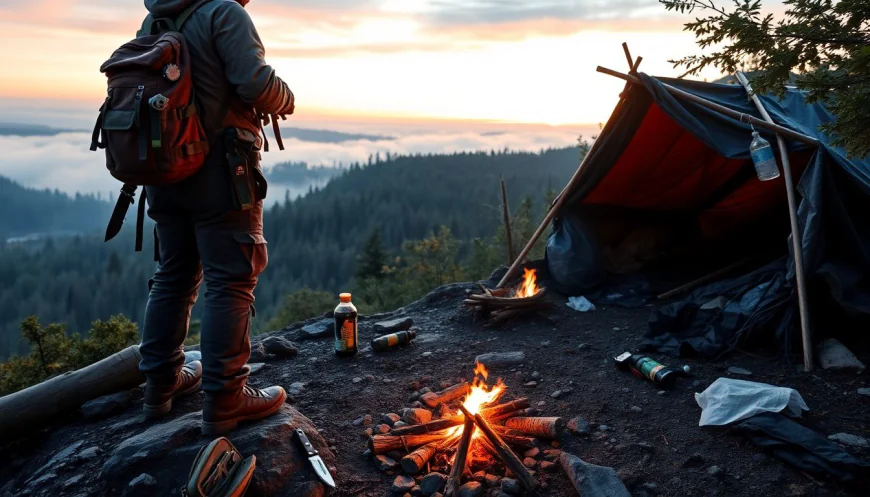Ultimate Guide to Survivalism: Prepare for the Unpredictable
In today’s world, natural disasters, economic troubles, and political unrest happen more often. These events can catch us off guard and leave us unprepared. That’s why many people are turning to survivalism— a movement focused on self-reliance and being ready for anything. Modern survivalism blends old skills with new technology, creating a smart way to stay safe. If you want to know how to face emergencies confidently, this guide will show you how to develop your survival skills and prepare for whatever comes your way.

Understanding Survivalism: Definition and Core Principles
What Is Survivalism?
Survivalism is about getting ready to survive tough times—whether that’s a natural disaster, economic collapse, or social chaos. It’s a lifestyle that focuses on self-sufficiency, resilience, and quick thinking. The movement started many decades ago, with roots in early survivalist groups during World War II and the Cold War. Today, it includes everyone from backpackers and hunters to urban dwellers wanting preparedness.
Key Principles of Survivalism
Survivalism is built on a few major ideas:
- Self-reliance: Relying on your own skills and supplies instead of others.
- Preparedness: Planning ahead for different disasters.
- Adaptability: Being flexible and ready to change plans when needed.
- Resilience: Bouncing back quickly after setbacks or emergencies.
Types of Survivalists
There are different kinds of survivalists depending on their locations and goals:
- Bug-in survivalists prefer staying at home and fortifying their shelter.
- Bug-out survivalists plan on evacuating to a safer location when needed.
- Urban survivalists focus on city environments, dealing with limited space and resources.
- Rural survivalists often have more land and space to grow food and build shelters.
Essential Survival Skills
Water Procurement and Purification
Water is life, yet many places face water shortages. Studies show about 2 billion people lack access to clean water. Knowing how to find and purify water can make a huge difference during survival situations. Techniques include:
- Harvesting rainwater
- Digging for groundwater
- Using portable filters or purification tablets to make water safe to drink
Carry gear like lightweight filters or chemical tablets; they’re small but powerful tools at crucial moments.
Food Storage and Foraging
Food storage helps you prepare for long-term emergencies. Options include freeze-dried meals, canned goods, and dehydrated foods that last for years. Foraging can also add variety—learning which local plants are edible or how to fish and hunt can extend your food supply during a crisis. Keep a supply of emergency rations and learn simple foraging skills to supplement your stored food.
Shelter Building and Emergency Housing
Shelter protects you from the elements and keeps you safe. Natural shelters built from branches or leaves work well in the wild, but prefabricated tents and emergency blankets are faster options. Understanding how to choose a safe location, insulate your shelter, and stay protected from weather is vital for survival.
First Aid and Medical Preparedness
In times of trouble, quick medical help can prevent minor injuries from turning dangerous. Carry a first aid kit and learn skills like bandaging wounds or treating burns. Recognize signs of illnesses like hypothermia or dehydration, and know how to handle common injuries until professional help arrives.
Survival Gear and Technology
Must-Have Equipment
Every survival kit should include:
- Multi-tools and knives
- Flashlights and headlamps
- Communication devices such as radios or satellite phones
- Power sources like solar chargers and extra batteries
Having reliable gear means staying connected and maintaining light and power when everything else fails.
Technology in Modern Survivalism
Tech makes survival easier and more efficient. GPS units can help you find your way if you get lost, while smartphone apps can provide weather alerts and emergency information. Smart devices and alert systems are becoming key tools for survival planning.
DIY and Homemade Gear
You can build many survival items yourself. Simple water filters made from sand and charcoal, or homemade containers from metal cans, are practical. Learning to make your own gear saves money and gives you backup options when store-bought supplies run out.
Planning and Strategy for Different Scenarios
Natural Disasters
Different disasters demand different plans. Earthquakes, hurricanes, and floods all require specific preparedness checklists. Know your evacuation routes, and have plans in place for quick escape or shelter-in-place. Practice drills help everyone stay calm and make better decisions.
Economic Collapse
When money loses value, having cash on hand and barter supplies becomes important. Stockpile supplies like fuel, medicine, and non-perishable food. Keep important documents safe and secure information on financial resources.
Civil Unrest and Social Disruption
In unstable times, safety comes first. Identify local safe zones, and avoid dangerous areas. Strengthen security at home with sturdy locks and barriers. Building friendships with neighbors and mutual aid groups can also provide backup in tense situations.
Long-Term Survival
Thinking beyond a few days means becoming more self-sufficient. Grow your own food with a garden, collect rainwater, and consider alternative energy sources like solar power. Living off-grid reduces dependence on external systems and increases your chances of long-term survival.
Building a Survivalist Community
Having others you trust makes facing tough times easier. Join or create local survival groups to share skills, resources, and information. Attend courses and workshops to learn from experienced survivalists. It’s also important to stay within the law and ethically source your supplies—avoiding illegal or harmful actions.
Conclusion
Survivalism isn’t just about stockpiling supplies. It’s a mindset rooted in preparing yourself physically, mentally, and emotionally. Start by learning key skills, gathering necessary gear, and planning for various scenarios. Being ready today can protect you and your loved ones tomorrow. Take action now, and build resilience for whatever the future holds. Your survival depends on your steps—so get started!



 VARSHITHA
VARSHITHA